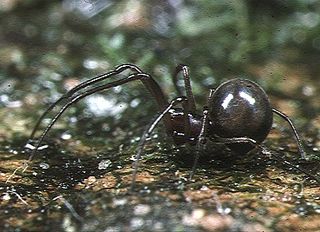
The spider family Liphistiidae, recognized by Tamerlan Thorell in 1869, comprises 8 genera and about 100 species of medium-sized spiders from Southeast Asia, China, and Japan. They are among the most basal living spiders, belonging to the suborder Mesothelae. In Japan, the Kimura spider is well known.

Theridiidae, also known as the tangle-web spiders, cobweb spiders and comb-footed spiders, is a large family of araneomorph spiders first described by Carl Jakob Sundevall in 1833. This diverse, globally distributed family includes over 3,000 species in 124 genera, and is the most common arthropod found in human dwellings throughout the world.

Linyphiidae is a family of very small spiders comprising 4706 described species in 620 genera worldwide. This makes Linyphiidae the second largest family of spiders after the Salticidae. The family is poorly known; new genera and species are still being discovered throughout the world. The newest such genus is Himalafurca from Nepal, formally described in April 2021 by Tanasevitch. Because of the difficulty in identifying such tiny spiders, there are regular changes in taxonomy as species are combined or divided.

Scaffold web spiders (Nesticidae) is a family of araneomorph spiders closely allied with tangle web spiders. Like the "Theridiidae", these spiders have a comb of serrated bristles on the hind tarsi that are used to pull silk bands from the spinnerets. It contains 16 genera and about 300 species, many of which are associated with caves or overhangs. The genus Nesticus is the type for the family and is found throughout the world. The related Eidmannella has speciated considerably in Texas caves and includes some extremely localized species that are considered threatened. One species, Eidmannella pallida, is found in caves and under overhangs, but also in agricultural fields and other habitats away from such restricted areas. The genus Carpathonesticus is found in central Eurasia.

Dwarf sheet spiders (Hahniidae) is a family of araneomorph spiders, first described by Philipp Bertkau in 1878. Their bodies are about 2 millimetres (0.079 in) long, and they build extremely delicate webs in the form of a sheet. Unlike many spiders the web does not lead to a retreat. The silk used in these webs is so fine that they are difficult to spot unless they are coated with dew. They greatly favor locations near water or near moss, and are often found in leaf litter and detritus or on the leaves of shrubs and trees.

Anapidae is a family of rather small spiders with 231 described species in 58 genera. It includes the former family Micropholcommatidae as the subfamily Micropholcommatinae, and the former family Holarchaeidae. Most species are less than 2 millimetres (0.079 in) long.
Synaphridae is a family of spiders with thirteen described species in three genera. It was first described as a subfamily of Anapidae, but it has since been raised to family status.

Archaeidae, also known as assassin spiders and pelican spiders, is a spider family with about ninety described species in five genera. It contains small spiders, ranging from 2 to 8 millimetres long, that prey exclusively on other spiders. They are unusual in that they have "necks", ranging from long and slender to short and fat. The name "pelican spider" refers to these elongated jaws and necks used to catch their prey. Living species of Archaeidae occur in South Africa, Madagascar and Australia, with the sister family Mecysmaucheniidae occurring in southern South America and New Zealand.

Dysdera is a genus of woodlouse hunting spiders that was first described by Pierre André Latreille in 1804. They originated from Central Asia to Central Europe.

Lasaeola is a genus of comb-footed spiders that was first described by Eugène Louis Simon in 1881. The type species was described under the name Pachydactylus pronus, but was renamed Lasaeola prona when it was discovered that the name "Pachydactylus" was preoccupied. Both this genus and Deliana were removed from the synonymy of Dipoena in 1988, but many of these species require more study before their placement is certain.
Spermophorides is a genus of cellar spiders that was first described by J. Wunderlich in 1992.

Agyneta is a genus of dwarf spiders that was first described by J. E. Hull in 1911.

Phrurolithidae is a family of araneomorph spiders first described by N. Banks in 1982. First included in the Corinnidae as the subfamily Phrurolithinae, later phylogenetic studies justified a separate family.

Megalepthyphantes is a genus of dwarf spiders that was first described by J. Wunderlich in 1994.
Canariellanum is a genus of European dwarf spiders that was first described by J. Wunderlich in 1987.
Canariphantes is a genus of dwarf spiders that was first described by J. Wunderlich in 1992. It might be a junior synonym of Lepthyphantes.
Minicia is a genus of dwarf spiders that was first described by Tamerlan Thorell in 1875.

Simitidion is a genus of comb-footed spiders that was first described by J. Wunderlich in 1992. As of June 2020 it contains three species, native to Africa, Asia and Europe, and introduced to Canada: S. agaricographum, S. lacuna, and S. simile.

Bassaniodes is a genus of crab spiders that was first described by Reginald Innes Pocock in 1903.

Liophrurillus is a monotypic genus of araneomorph spiders in the family Phrurolithidae, containing the single species, Liophrurillus flavitarsis. It was first described by J. Wunderlich in 1992 as a possible corinnid sac spider, and was moved to Phrurolithidae in 2014. It has only been found in Europe and North Africa.















